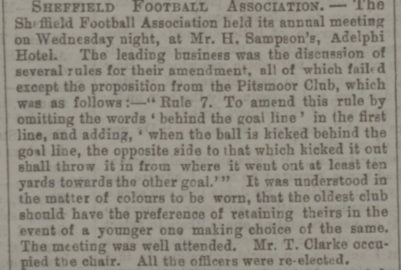Sheffield FA und London FA 1877
In der Darstellung der Sheffield FA Rules ist es schon angeklungen: 1877 übernahm die Sheffield FA die FA Rules, nachdem über mehrere Jahre immer wieder versucht wurde, Kompromisse zu finden. Es gab immer wieder Treffen, insbesondere zwischen John Charles Shaw und Charles William Alcock. Es gab Annährungsversuche und offene Dissonanzen zwischen den beiden Verbänden über die Regeln für Assoziationsfußball. Auch war immer ein Vertreter des Sheffield FC, ab 1867 der Sheffield FA bei den jährlichen Generalversammlungen der FA in London anwesend und auch im Komitee vertreten. Ich weiß aber aktuell nicht, wie die Beziehung von Sheffield FC bzw. FA zur Londoner FA waren, denn alle Mitglieder mussten zwingend nach FA Rules spielen, was in Sheffield ja nicht praktiziert wurde. • Beide organisierten für den 2. Dezember 1871 mit Sir John Charles Clegg auch ein Spiel zwischen Auswahlen beider Verbände, um die Regeln des anderen auszuprobieren. Shaw und Alcock waren die Kapitäne der beiden Auswahlen. Man kam aber noch zu keiner Einigung. 1872 übernahm aber die FA den Eckstoß der Sheffield FA Rules. 1875 kam es nicht …




